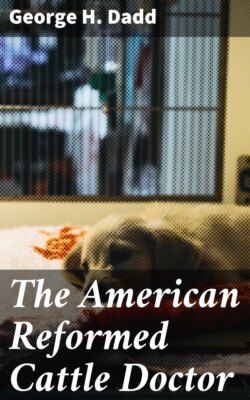Читать книгу The American Reformed Cattle Doctor - George H. Dadd - Страница 6
На сайте Литреса книга снята с продажи.
REMARKS ON FEEDING CATTLE.
ОглавлениеTable of Contents
Many of the most complicated diseases of cattle originate from the food: for example, it may be given in too large quantities—more than is needed to build up and repair the waste that is constantly going on. The consequence is, the animals get into a state of plethora, which is known by heaviness, dulness, unwillingness to move; there is a disposition to sleep, and they will lie down and often go to sleep in damp places. A chill of the extremities, or collapse of the capillaries, takes place, resulting in diseases of the lungs and pleura. At other times, if driven a short distance, and made to walk fast, they are liable to disease of the brain and other organs, which frequently terminates fatally.
The food may be of such a nature as shall be very difficult of digestion, such as cornstalks, foxgrass, frosted turnips, &c. The clover and grasses may abound in woody fibre, in consequence of being cut too late; they will then require more than the usual amount of gastric fluids to insalivate them, and more time to masticate, and, finally, extract their nutrimental properties. The stomach becomes overworked, producing sympathetic diseases of the brain and nervous structures. The stomach not being able to act on fibrous matter with the same despatch as on softer materials, the former accumulates in its different compartments, distends the viscera, interferes with the motion of the diaphragm, presses on the liver, seriously interfering with the bile-secreting process. In order to prevent the grass and clover from becoming tough and fibrous, it should be mowed early, and while in flower, and should be afterwards almost constantly attended to, if the weather is favorable; the more it is scattered about, the better will it be made, and the more effectually will its fragrance and other good qualities be preserved.
The food may also be deficient in nutriment. The effects of insufficient food are too well known to need much description: debility includes them all; it invades every function of the animal economy. And as life is the sum of the powers that resist disease, if disease is only the instrument of death, it follows, of course, that whatever enfeebles life, or, in other words, produces debility, must predispose to disease.
Many cattle, during the winter, live on bad hay, which does not appear to contain any of that saccharine and mucilaginous matter which is found in good hay. When the spring comes, they are turned out to grass, and thus regain their flesh. Many, however, die in consequence of the sudden change.
It has been satisfactorily proved that fat cattle, of the best quality, may be produced by feeding them on boiled food.
Dr. Whitlaw says, "On one occasion, a number of cows were selected from a large stock, for the express purpose of making the trial: they were such as appeared to be of the best kind, and those that gave the richest milk. In order to ascertain what particular food would produce the best milk, different species of grass and clover were tried separately, and the quality and flavor of the butter were found to vary very much. But what was of the most importance, many of the grasses were found to be coated with silecia, or decomposed sand, too hard and insoluble for the stomachs of cattle. In consequence of this, the grass was cut and well steamed, and it was found to be readily digested; and the butter, that was made from the milk, much firmer, better flavored, and would keep longer without salt than any other kind. Another circumstance that attended the experiment was that, in all the various grasses and grain that were intended by our Creator as food for man or beast, the various oils that enter into their composition were so powerfully assimilated or combined with the other properties of the farinaceous plants, that the oil partook of the character of essential oil, and was not so easily evaporated as that of poisonous vegetables; and experience has proved that the same quantity of grass, steamed and given to the cattle, will produce more butter than when given in its dry state. This fact being established from numerous experiments, then there must be a great saving and superiority in this mode of feeding. The meat of such cattle is more wholesome, tender, and better flavored than when fed in the ordinary way." (For process of steaming, see Dadd's work on the Horse, p. 67.)
A mixed diet (boiled) is supposed to be the most economical for fattening cattle. "A Scotchman, who fattens 150 head of Galloway cattle, annually, finds it most profitable to feed with bruised flaxseed, boiled with meal or barley, oats or Indian corn, at the rate of one part flaxseed to three parts meal, by weight,—the cooked compound to be afterwards mixed with cut straw or hay. From four to twelve pounds of the compound are given to each beast per day." The editor of the Albany Cultivator adds, "Would it not be well for some of our farmers, who stall-feed cattle, to try this or a similar mode? We are by no means certain that the ordinary food (meaning, probably, bad hay and cornstalks) would pay the expense of cooking; but flaxseed is known to be highly nutritious, and the cooking would not only facilitate its digestion, but it would serve, by mixing, to render the other food palatable, and, by promoting the appetite and health of the animal, would be likely to hasten its thrift."
Mr. Hutton, who has long been celebrated for producing exceedingly fat cattle at a small cost, estimates that cost as follows:—
